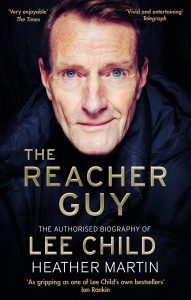Palimpsest
 Palimpsest
Palimpsest
Heather Martin, author of The Reacher Guy
It started as a conversation and ended as a book. That was the story I told, and it wasn’t a lie. But the truth is there is no beginning, and there is no end, when it comes to books. One book always comes from and leads to another, and then another and another after that.
The conversation I had with Lee Child was about life, writing, and books. Naturally, I wanted to represent that conversation in the book of which he was the subject, not least because his was the voice readers wanted to hear. His was the voice that sold tickets, that packed out venues around the globe and had fans queuing for hours just to exchange a few words with him.
Fans flocked to hear him speak because of Jack Reacher, then returned with their friends for Lee Child, who had given Reacher his voice in the first place. Sometimes, it was difficult to tell them apart, and increasingly in the popularity stakes Child was giving Reacher a run for his money. Hence the biography, which would allow me to write about both, and their shadowy creator Jim Grant.
The debut author of Killing Floor chose a fragmentary, choppy, faux-naif style to suit a hero who would use words sparingly but with precision, citing as influences the stilted, staccato expression of Kevin Costner in Dances with Wolves and the unpolished teenage narration of Linda Manz in Terence Malik’s Days of Heaven. Literary voice was more than a metaphor: ‘It had to be like someone was speaking a story to me.’ The New York Times no. 1 of fifty thousand years ago was the guy you most enjoyed listening to, and Lee wanted to tap straight into that ancient collective memory, which was why he settled on the first person for his first book, as ‘the natural way’ of telling a story.
That no. 1 voice was a gift audiences recognised. I once heard Lee tell a bunch of high school students that if you could tell a story over lunch to a friend, then you could write a book. His point was that we inflate the importance of ‘being a writer’, making a big deal out of something that is a job like any other. But not everyone finds it that simple. Lee was the beneficiary of good genes and a first-class education, and was quick to acknowledge, too, that he enjoyed the structural advantages of being a white middle-class male.
For me as biographer it wasn’t merely a matter of direct quotation, or even paraphrase. Sometimes I found myself adopting Lee’s vocabulary, such as using the noun ‘guy’ more freely than I normally would because it was the choice I knew he would make. Words and phrases of his inserted themselves irresistibly into my story of his life.
I was conscious of what I was doing, but it wasn’t willed or planned or premeditated: it just felt right, and since I was following Lee’s paradoxical advice to ignore all writing advice, instinct was what steered me through from first word to last. Perhaps – as did he in writing a series about a recurrent and largely ageless character – I wanted readers who picked up The Reacher Guy to experience a sense of recognition and familiarity, to feel ‘welcomed and comfortable when they [came] into the book’, like they were pulling on an old sweater. Or perhaps that was the experience I was seeking myself.
It was there for all to see. I didn’t try to hide it. I felt no shame in borrowing Lee’s description of Reacher in The Midnight Line to describe the man who wrote it on page one of my book:
‘Tall and fair-haired and blue-eyed. Hair that was dirty blond. Eyes that could blink and come back different, like changing the channel, from a happy show to some bleak documentary about prehistorical survival a million years ago.’
And when I was writing about Lee and mirrors, it felt right to steal from his first New York Times no.1 Nothing to Lose to convey his thoughts about his own appearance, which ‘he had no real opinion about’ since ‘it was what it was’ and ‘he couldn’t change it’ and ‘some people liked it, and some people didn’t’. Those matter-of-fact statements, so stark in their simplicity, seemed to capture something essential about the man I was writing about.
I’d read my Roland Barthes and my Jorge Luis Borges (and enough of my Classics). I knew that all writing was rewriting, a tissue of quotations. I knew that every man who repeats a line of William Shakespeare is William Shakespeare, and that my preferences in this matter counted for zero. Words only worked because we had seen and heard them before. My words would grow around those of my subject like sweet peas on twisted willow.
The designer had captured it perfectly on the back cover of the new paperback edition of The Reacher Guy. Headlining were quotes from the Irish Times and Ian Rankin: the gold foil made them pop out from the page. Below, picked out in bright white but by comparison recessed, was the publisher’s blurb. Quotes and blurb were set against the ghostly background of Lee’s own words, from the handwritten manuscript of Killing Floor, then titled Bad Luck and Trouble. But at that point in history ‘Lee Child’ was little more than a veil or veneer, beneath which hovered one James Dover Grant, aka Jim.
At the top, in pale blue ink, is another famous name, above two words that have been crossed out: if you look carefully, you can make out what the soon-to-be multi-million-selling Jack was called – oh so briefly – as he evolved from ‘H for hero’ to the Reacher we all know and love.
The Reacher Guy is a palimpsest, peeling back the layers, and adding some new ones too.
—
Heather Martin is the author of The Reacher Guy: the Authorised Biography of Lee Child, out in paperback on 21st October from Little, Brown UK with a new postscript.
THE REACHER GUY, Heather Martin
 ‘A biography as gripping as one of Lee Child’s own bestsellers’ Ian Rankin
‘A biography as gripping as one of Lee Child’s own bestsellers’ Ian Rankin
‘Very enjoyable’ The Times
‘Vivid and entertaining’ Telegraph
Jack Reacher is only the second of Jim Grant’s great fictional characters: the first is Lee Child himself. Heather Martin’s biography tells the story of all three.
Lee Child is the enigmatic powerhouse behind the bestselling Jack Reacher novels. With millions of devoted fans across the globe, and over a hundred million copies of his books sold in more than forty languages, he is that rarity, a writer who is lauded by critics and revered by readers. And yet curiously little has been written about the man himself.
The Reacher Guy is a compelling and authoritative portrait of the artist as a young man, refracted through the life of his fictional avatar, Jack Reacher. Through parallels drawn between Child and his literary creation, it tells the story of how a boy from Birmingham with a ferocious appetite for reading grew up to become a high-flying TV executive, before coming full circle and establishing himself as the strongest brand in publishing.
Heather Martin explores Child’s lifelong fascination with America, and shows how the Reacher novels fed and fuelled this obsession, shedding light on the opaque process of publishing a novel along the way. Drawing on her conversations and correspondence with Child over a number of years, as well as interviews with his friends, teachers and colleagues, she forensically pieces together his life, traversing back through the generations to Northern Ireland and County Durham, and following the trajectory of his extraordinary career via New York and Hollywood until the climactic moment when, in 2020, having written a continuous series of twenty-four books, he finally breaks free of his fictional creation.
https://www.amazon.co.uk/Reacher-Guy-Authorised-Biography-Child/dp/1472134230/
https://www.amazon.com/Reacher-Guy-Biography-Lee-Child/dp/1643135864/
Category: On Writing























